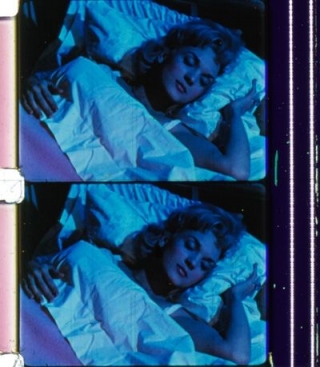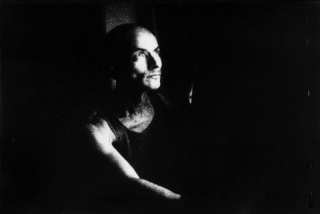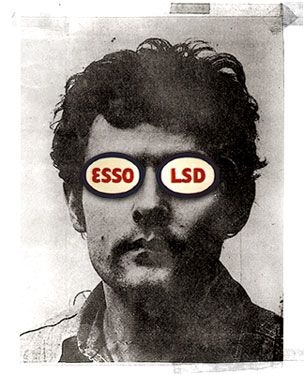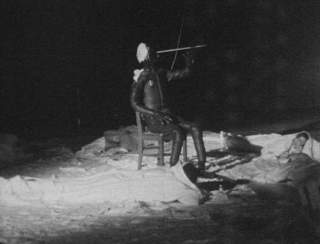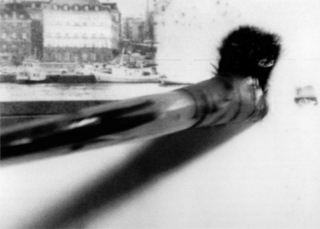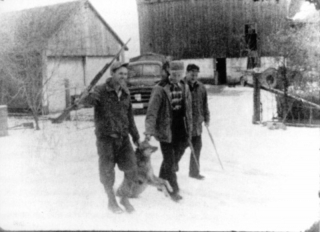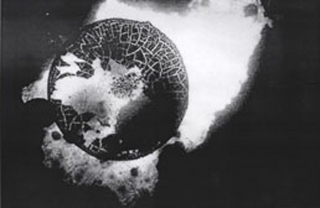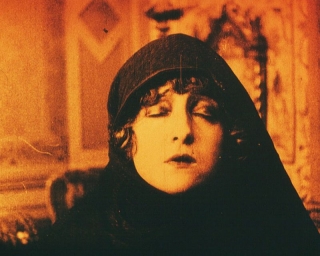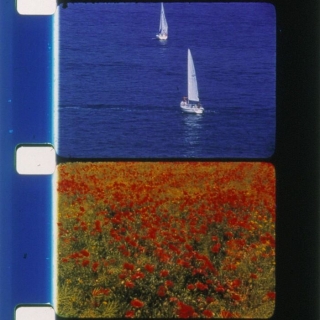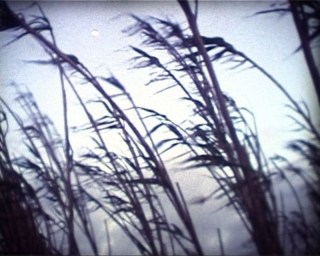Date: 11 September 2002 | Season: LUX Salon
LUX SALON: NEW GERMAN CINEMA with Thomas Draschan
Wednesday 11 September 2002, at 7:30pm
London LUX
German Filmmaker Thomas Draschan presents a special programme of new experimental cinema from Germany including work by Draschan, Ulrich Wiesner, Thomas Feldmann, Kerstin Cmelka, Goh Harada and Nino Pezzella.
Thomas Draschan was a student of Peter Kubelka at the Stadelschule in Frankfurt and co-curated the programme ‘In Kubelka’s Shadow’ at the 2001 London Film Festival, which included earlier works by several of the filmmakers that are featured tonight. He works independently to organise the Frankfurt Filmschau, and the Independent Film Show in Naples.
Thomas Draschan, Yes Oui Ja, 2003, 16mm, colour, sound, 4 min
Ulrich Wiesner, Afrika Bonus, 1982, 16mm, colour, sound, 3 min
Ulrich Wiesner, Deutschland Lacht (Germany Laughs), 1982, 16mm, colour, sound, 3 min
Thomas Feldmann, 2 Chinesische Zeichen (2 Chinese Signs), 1982, 16mm, colour, sound, 2 x 2 min
Goh Harada, Blaufilm, 1999-2000, 16mm, colour, silent, 10 min
Nino Pezzella, Zum Briefkasten, 1989-2002, 16mm, colour, sound, 17 min
Date: 18 September 2002 | Season: Infinite Projection
TOM, A STOLEN BIOGRAPHY
Wednesday 18 September 2002, at 7:30pm
London The Photographers’ Gallery
Crystalline glances at the life of notorious gay cineaste Tom Chomont told through a symphony of stolen footage. Chomont recounts his artistic and personal history, shadowed by his battle with AIDS and Parkinson’s Disease, while Hoolboom weaves the visual tapestry. Tom is biography told as if a dream, unconsciously drifting between private and collective experience.
Mike Hoolboom, Tom, 2002, 75 min
PROGRAMME NOTES
TOM, A STOLEN BIOGRAPHY
Wednesday 18 September 2002, at 7:30pm
London The Photographers’ Gallery
TOM, A STOLEN BIOGRAPHY
Mike Hoolboom, Canada, 2002, video, colour, sound, 75 min
“Tom is an ‘experimental’ feature-length documentary made almost entirely of found footage. This is cinema as deja vu, or deja voodoo; many moments will feel all too familiar, though they’ve been projected now onto the surface of a life to make up this most unusual of biographies. The history of a city, New York City, the most photographed city in the world, operates as a backdrop for the life of Tom Chomont, a key member of the New York underground, a notorious video artist, AIDS sufferer, raconteur. His fantastical stories punctuate the weave of pictures, and a rare white light which he imagines as both the beginning and end of all life. As the decades roll past, excerpts from hundreds of films, some archival documents, some well known Hollywood moments, stream past in a hypnotic rush offering a subject whose skin is cinema, whose flesh and blood has been re-made into the picture plane.
“This portrait is strained thru a history of pictures which come to inhabit their subject, this Tom, this once human. These pictures have taken hold of their subject and reshaped him, moments from a thousand movies have become his life and imagination, the possibility of love. This portrait teases these pictures out of his skin and the skin of his New York City, whose secret histories merge at last with the memories of one of its most underground citizens.
“From his mouth a confession: living is also grieving, an act accomplished in the theatre of sadomasochism where he can return to the memory of his brother, sleeping with his brother’s lovers as he once slept with him, the forbidden apple of his family’s eye, the man closer to him than any other.
“This is the society of the spectacle rewritten as biography, shooting the individual through the vanishing point until there is nothing left but masks, a face which appears as pictures and the memory of tears.”
(Mike Hoolboom, 2002)
Back to top
Date: 14 October 2002 | Season: Oyvind Fahlstrom
ÖYVIND FAHLSTROM & SWEDISH AVANT-GARDE FILM
14 October–24 November 2002
Gateshead BALTIC Centre
Since the 1950s, the artist Öyvind Fahlström pursued an interest in the moving image. The use of illustration and collage in his paintings and graphic work show a clear affinity to cinema and the use of film as a means of artistic expression. He was an active member of Arbetsgruppen För Film (aka Filmform); an artist-led organisation dedicated to the production and promotion of avant-garde film, and made experimental tv documentaries, home movies and the radical feature film Du Gamla Du Fria (which takes its name from the Swedish national anthem).
One of the earliest films ever made by an artist was Symphonie Diagonale by the Swedish painter Viking Eggeling in the early 1920s, but independent film did not become established in Sweden until the post-war period, at which time personal psychodramas and city symphonies were made by filmmakers such as Gösta Werner, Peter Weiss and Nils Jönsson.
Avant-garde film flourished as a potent artform in the 1960s counterculture. The artists Åke Karlung and Erling Johansson made extraordinary films as part of their wider creative practice, using animation to assemble mixtures of painting, sculpture and live action. Other filmmakers, including Hans Esselius and Jan Håfström used cinema to make potent social commentary, attacking the modern political and industrial establishment. Fahlström himself made the satirical, psychedelic found-footage film U-barn for the Swedish Film Institute. In the 70s and 80s, Åsa Sjöström, Olle Hedman Anne-Sofi Sidén and others continued to experiment with the medium as a punk ethos brought the work back-to-basics.
The artist Gunvor Nelson lived and worked in San Francisco for many years, though she never lost her close connection to the culture and character of her birthplace. Gunvor will be at BALTIC to present two programmes of her work, featuring both her unique collage techniques and her deeply personal films about family relationships.
In this brief history of the Swedish avant-garde, examples of Fahlström’s own work will be shown alongside rare screenings of films by those who still remain widely unknown outside their homeland.
Date: 14 October 2002 | Season: Oyvind Fahlstrom
EXPERIMENTS IN ART & TECHNOLOGY: 9 EVENINGS
Monday 14 October 2002, at 6:15pm
Gateshead BALTIC Centre
Introductory lecture and slide show by Billy Klüver, founder of E.A.T. (Experiments in Art & Technology). Klüver will discuss the work of Öyvind Fahlström, with particular reference to the multi-media performance Kisses Sweeter Than Wine.
Barbro Schultz Lundestam, Öyvind Fahlström: Kisses Sweeter Than Wine, 1966, b/w & colour, sound, 71 min
Back to top
Date: 16 October 2002 | Season: Infinite Projection
COLLAGE FILMS OF GUNVOR NELSON
Wednesday 16 October 2002, at 7:30pm
London The Photographers’ Gallery
Gunvor Nelson’s collage work extends the artistic possibilities of animation and layered imagery, combining disparate elements into a temporal, cinematic painting. In this sequence of films from the 1980s, journeys through the Swedish landscape are used to depict a sense of displacement from her native country. By showing animation as a process, Nelson creates a unique and freewheeling chain of evocative transformations.
Gunvor Nelson, Light Years, Sweden, 1987, colour, sound, 28 min
Gunvor Nelson, Frame Line, Sweden, 1984, b/w, sound, 22 min
Gunvor Nelson, Light Years Expanding, Sweden, 1987, colour, sound, 25 min
This screening takes place in conjunction with a retrospective of Swedish avant-garde film presented by the Baltic Centre, Gateshead.
PROGRAMME NOTES
COLLAGE FILMS OF GUNVOR NELSON
Wednesday 16 October 2002, at 7:30pm
London The Photographers’ Gallery
Gunvor Nelson, Light Years, Sweden, 1987, colour, sound, 28 min
Gunvor Nelson, Frame Line, Sweden, 1984, b/w, sound, 22 min
Gunvor Nelson, Light Years Expanding, Sweden, 1987, colour, sound, 25 min
“Frame Line is a collage film in black and white. Glimpses (both visual and audible) of Stockholm, people, gestures, flags and the Swedish national anthem appear through drawings, paintings and cut-outs. It is a film with an eerie flow between the ugly and the beautiful about returning, about roots and also about reshaping. Light Years is a collage film and a journey through the Swedish landscape, traversing stellar distances in units of 5878 trillion miles. It is a film acutely in the present reflecting our temporal existence … continuous and imperfect.” (Gunvor Nelson, Canyon Cinema catalogue)
“Light Years continues to develop the concerns and techniques begun in her earlier film Frame Line. In Light Years Nelson blends collage animation with highly textured live-action material to create a haunting evocation of her displacement from her native Swedish culture. Particularly striking is her use of wet ink on glass to create a constantly shifting image of a path leading to a house. With these passages of the house and moving images of the Swedish landscape as threads, Light Years becomes a tapestry of change as experienced through constant motion. It is a personal reflection on the filmmaker’s memories of her past. The film is so filled with visual ideas that Gunvor Nelson has extended the film’s themes and techniques in her subsequent effort Light Years Expanding. All her recent films suggest that while the distance of time makes home further, the intensity of memory makes it richer.” (Parabola)
Back to top
Date: 16 October 2002 | Season: Infinite Projection
JACK CHAMBERS’ HART OF LONDON
Wednesday 16 October 2002, at 7:30pm
London The Photographers’ Gallery
Canadian artist Jack Chambers made Hart of London at a time when he was diagnosed with leukaemia and given two months to live. Developing from his concept of ‘perceptual realism’, this incredible film rises from dense layers of superimposition before slipping into sharp focus and powerful clarity. The accumulation of images evokes universal memory through waves of nostalgia, emotion and wonderment. An awesome contemplation on mortality, creation and destruction: All life (and death) is here, humanity laid bare.
Jack Chambers, Hart of London, 1969-70, 79 min
Presented in association with the Canadian High Commission, who have generously bought a new print of the film for European distribution by LUX. With thanks to John Chambers and Maggie Warwick.
PROGRAMME NOTES
JACK CHAMBERS’ HART OF LONDON
Wednesday 16 October 2002, at 7:30pm
London The Photographers’ Gallery
HART OF LONDON
Jack Chambers, Canada, 1969-70, b/w & colour, sound, 79 min
“Hart of London (1969-70), Chambers’ last film, is a dense, feature-length, multi-image symphonic work whose scope is breathtaking. Without doubt it is a masterwork. In its quick cutting, its transitions from positive to negative imagery, its jittery, anxious camera movement, its vision of death as the slaughter of innocents, and above all its deep interest in the qualities of light, it resembles the work of American avant-garde filmmaker Stan Brakhage, whom Chambers much admired. Although Chambers’ familiarity with Brakhage’s work may have expanded his formal vocabulary, the film remains unmistakably his own. Hart of London is composed largely of newsreel, proto-cinematographic images which are wedded to a particular place and time. For this reason they evoke a sense of loss. These images are often arranged in patterns which consist in the alternation of icons of birth with icons of death. Made shortly after Chambers learned that he was suffering from leukaemia, the film, rather than suggesting that death balances birth, implies that death sooner or later savages every living thing.” (R. Bruce Elder, Image and Identity: Reflections of Canadian Film and Identity, 1989)
Back to top
Date: 9 November 2002 | Season: London Film Festival 2002 | Tags: London Film Festival
WITHIN THE REALMS OF ABSTRACTION
Saturday 9 November 2002, at 12pm
London National Film Theatre NFT3
Fred Worden, Automatic Writing 2, USA, 2000, 12 min
Negotiating the mysterious zone where light and no-light flutter in a fecund equipoise: A home-made rocket to realms unknown to any movie camera or photo lens.
Richard Reeves, 1:1, Canada, 2001, 5 min
Cameraless animation about the 1:1 relationship between sound & picture, scratched and painted onto 35mm film.
Joost Rekveld, 23:2 Book of Mirrors, Netherlands, 2002, 12 min
The multiplication of light beams through mirrors and kaleidoscopes. Music composed by Rozalie Hirs and performed by the Asko Ensemble.
Jud Yalkut, Light Display: Color, USA, 2002, 7 min
Analogue and digital transformations of footage shot of Laslo Moholy-Nagy’s kinetic sculpture ‘Light Display Machine’.
Fred Worden, The Or Cloud, USA, 2001, 6 min
A guided adventure for the eyeballs and the mind; a rushing stream of articulated energy to resonate with the inner biological current.
Goh Harada, Blaufilm, Japan-Germany, 2001, 10 min
Hand-made ‘imageless’ film created using only blank film, transparent silicone and blue pigment.
Stan Brakhage, Lovesong 4, USA, 2002, 7 min
‘Composed of only four colours: Lavender, Purple, Green, and Turquoise. Their dance with the darkness suggests an inter-action of bodies.’ Despite continued battles with ill health, Stan Brakhage continues to issue forth with exquisite hand-painted films.
Pip Chodorov, Charlemagne 2: Pilzer, France, 2002, 22 min
Footage of a private piano concert by Charlemagne Palestine is broken down into a meticulously structured flicker film through the optical printing of positive and negative frames. Each individual image corresponds to the notes played on the soundtrack (the live performance) by way of their audio/visual frequency and rate of progression.
Repeat Screening: Monday 11 November 2002, at 6:30pm, London NFT3
Back to top
Date: 9 November 2002 | Season: London Film Festival 2002 | Tags: London Film Festival
FILM IST 7-12
Saturday 9 November 2002, at 6:20pm
London ICA Cinema 2
Gustav Deutsch, FILM IST 7-12, Austria, 2002, 93 min
FILM IST 7-12 is the second in a series of proposed ‘tableau films’ by Gustav Deutsch. The twelve chapters, each illustrating a particular theme or theory, are discreet works which may be shown in any combination, but together build into a discourse on the phenomenology of the cinematic medium. While FILM IST 1-6 (1998) proposed the science laboratory as one birthplace of film, the more anthropological sections 7-12 focuses on variety; using tricks, humour and theatre, to trace a lineage back to the innovations of Georges Méliès. Made with the assistance of five major international film archives, it comprises of footage from the first thirty years of documentary and feature film-making. Revelling in the rich history of cinema’s early years, Deutsch constructs a celebration of cinema using travelogues, trick films, propaganda, comedy, drama and observation. Cinema’s magic box is opened up and immortalised. Contemporary electronic soundscapes created by Werner Dafeldecker, Christian Fennesz, Martin Siewert and Burkhard Stangl complement the images.
screening with
Peter Tscherkassky, Dream Work, Austria, 2002, 11 min
A surrealistic excavation of the dream world told as fractured mystery / split narrative. Utilising Man Ray’s ‘rayograph’ technique and based on footage from Sidney J. Furey’s 1982 feature The Entity, Dream Work is the final part of an award winning Cinemascope trilogy which includes Outer Space and L’Arrivée.
Also Screening: Monday 11 November 2002, at 8:45 pm, London NFT3
Back to top
Date: 12 November 2002 | Season: London Film Festival 2002 | Tags: London Film Festival
NATURAL BEAUTY
Tuesday 12 November 2002, at 2pm
London National Film Theatre NFT3
Diane Kitchen, Wot the Ancient Sod, USA, 2001, 17 min
‘As delicate in its observation as it is magnificent in its discoveries, Wot the Ancient Sod is a walk through the woods, a survey of intimate scrutiny alert to the unconsidered splendours of the colours, forms and spaces comprising our natural surroundings.’ (Carl Bogner, Woodland Pattern Experimental Film Series)
Rose Lowder, Bouquets 21-24, France, 2001, 6 min
The Bouquets are constructed frame-by-frame, in camera, by alternating single images of specific pastoral locations. The images are clusters of perception, which build into improvised portraits of the flowers and vegetation at each site. Condensed moments of time and space form visual bouquets, planted on our retinas, blooming with rich colour and vitality.
Rose Lowder, Voiliers et Coquelicots, France, 2001, 4 min
In subtle optic wit, poppies and sailboats vie for our attention as they are juxtaposed in consecutive frames. ‘Little is necessary for everything to appear differently. The date, the hour, the weather, the space’s layout, one’s glance or presence of mind … can make everything change’.
Emmanuel Lefrant, Underground, France, 2001, 8 min
The secret forms of the emulsion are revealed in a hand-made film which suggests constantly evolving golden brown organic matter.
Stan Brakhage, Micro Garden, USA, 2001, 3 min
‘Red and ephemeral blue and purple plant shapes half-curled against a tan ground, which begins to flash white cracks in dried mud patterns. A flush of watery brightens the plant-skein into a variety of greens mixed into all other colours – all darkening into smeared mud-blacks with microscopic beseeming black ‘splatters’ (where mud-like cracks used to be).’
Stan Brakhage & Phil Solomon, Seasons …, USA, 1999-2002, 20 min
Painted, etched and engraved by Brakhage, printed and edited by Solomon: two of America’s finest film-makers unite to present a tour-de-force fusion of natural and chemical wonder. The world premiere of a long laboured masterpiece ‘inspired by the colours and textures found in the woodcuts of Hokusai and Hiroshige, and the playful sense of forms dancing in space from the filmworks of Robert Breer and Len Lye.’
Repeat Screening: Wednesday 13 November 2002, at 4:15pm, London NFT3
Back to top
Date: 13 November 2002 | Season: London Film Festival 2002 | Tags: London Film Festival
CONTEMPLATING SPACE
Wednesday 13 November 2002, at 6:30pm
London National Film Theatre NFT3
Renata Sancho, Paisagem, Portugal, 2001, 17 min
A journey from the rain forest to the beach, mostly seen from fixed viewpoints, captures the spirit of the landscape. A film notebook of a voyage inspired by the writings of Carlos di Oliveira.
Kerstin Cmelka, Camera, Germany, 2002, 9 min
By building visual architectural constructs within the camera using mattes and time-lapse, Cmelka offers us views of spaces which do not exist.
Robert Fenz, Meditations on Revolution, Part III: Soledad, USA-Mexico, 2001, 15 min
‘Images of Mexico City, San Cristobal de las Casas and New York. Mexico seems timeless: past, present and future – revolution always played a role. New York gives the picture back its feeling for time and space.’
Peter Hutton, Looking at the Sea, USA-Ireland, 2001, 17 min
‘A meditation on the light, colour and texture of the land and seascapes along the west coast of Ireland’. An exquisitely photographed cine-poem by Peter Hutton, whose films study the world in serene contemplation.
Nathaniel Dorsky, Love’s Refrain, USA, 2001, 23 min
‘One of the foremost avant-garde film-makers working today, San Francisco-based experimental film-maker Nathaniel Dorsky creates films that are silent, non-narrative and forged by seamless editing of astonishing precision. Dorsky’s exquisite cinema of silence unveils the rich rewards of losing oneself in delicate framing, minute gradations of light and shadow, or the examination of the actual grain of the film stock, to arrive at the discovery of beauty in the most quotidian images. (Jytta Jensen, MoMA, New York)
Repeat Screening: Friday 14 November 2002, at 2pm, London NFT3
Back to top
